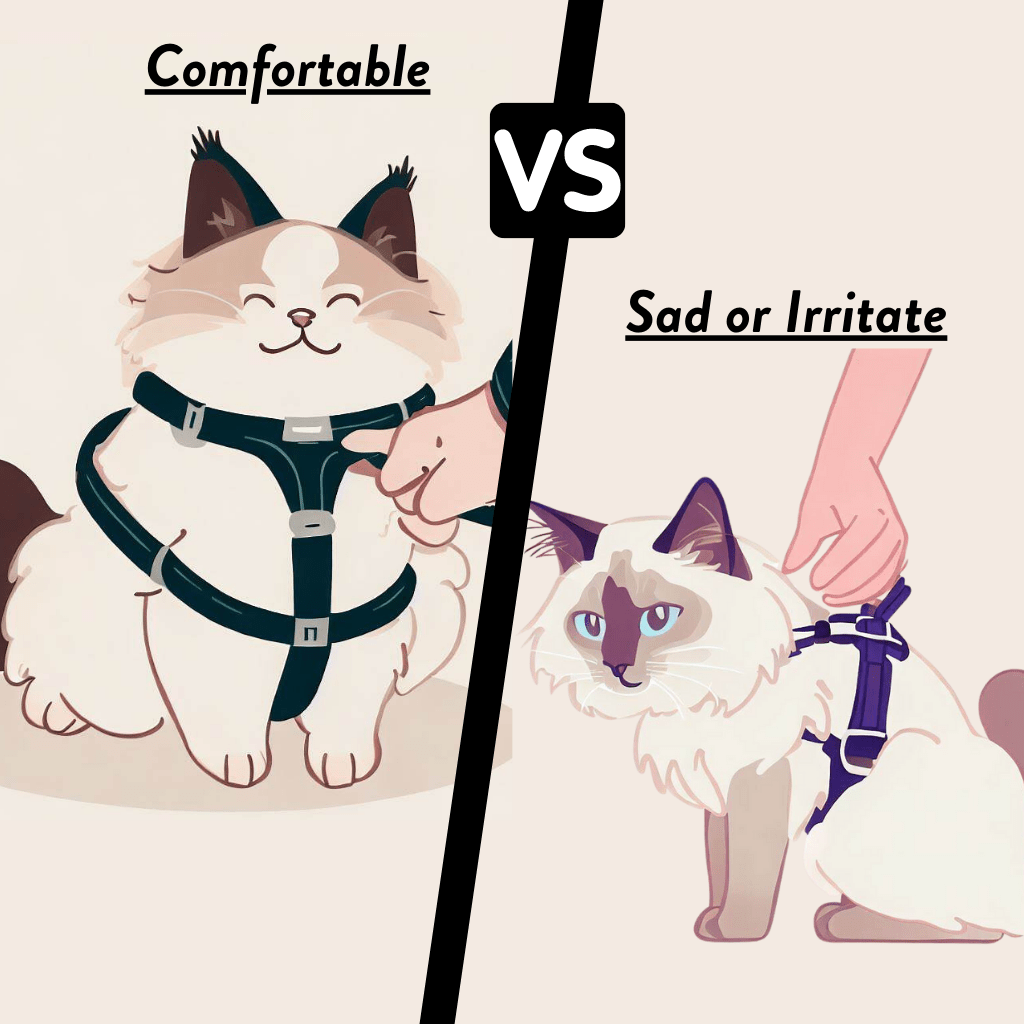How to Train Ragdoll Walking on Leash or Harness? [With Pictures]

Taking your Ragdoll cat outdoors for a walk is necessary, but before you do that, ensure to train Ragdoll walking on leash or harness. This will guarantee their safety, and you’ll be able to enjoy a good time with your Ragdoll without worrying about any mishaps.
The question is HOW? How you can train Ragdoll walking on leash or harness? Is training an easy process? As per my experience, training isn’t difficult as many thought, but it requires lots of patience, hard work and, most importantly, time.
Generally, the training will be around four weeks longer; the time can decrease or increase depending on how your Ragdoll responds. So let’s get into the details below to discuss the training process step-by-step!
Quick Answer – How to Train Ragdoll Walking on Leash or Harness?
- Gather Necessary Supplies: Prepare the essential items, such as treats, a suitable harness or leash, a target stick, and a gentle clicker, all tailored to your Ragdoll cat’s preferences.
- Introduce the Harness or Leash Gradually: Familiarize your cat with the harness or leash by leaving it in their play area. Employ a clicker and treats to reward your Ragdoll whenever they interact with the leash or harness positively. (Follow this for a few days daily)
- Properly Fit the Harness or Leash: Put on the harness or leash and ensure it fits comfortably, leaving enough space for one or two fingers between the harness and your Ragdoll. Encourage your cat to move with the leash or harness on by using toys and a target stick. (Do this for a week till your cat become comfortable).
- Choose a Safe Walking Location: When it’s time for outdoor walks, start in peaceful, clean areas like a quiet park with minimal pet traffic. Carry the target stick, clicker, treats, and your cat’s favorite toy to reward good behavior during walks.
Step-by-Step Guide to Train Ragdoll Walking on Leash or Harness
Below I’ll share my personal experience, like how I trained my two Ragdoll cats. Believe me, the process isn’t too difficult, but you need to be patient. Otherwise, you’ll end up forcing the training on your cat, leading to a situation where your Ragdoll will hate seeing the leash or harness.
Get all supplies
The most important part is to get all supplies for the training. I’m not asking to buy a lot, but you need a few items like a Target stick, a harness, etc. Remember to pick all of these items according to your Ragdoll cat, particularly the harness, leash or treats.
- Treat (choose what your Ragdoll likes).
- Harness or Leash (select it according to the Ragdoll size).
- Target stick (it should be lightweight and durable).
- Clicker (don’t choose a clicker with a sharp, loud sound, it could frighten the Ragdoll).
Read which is better, a harness or a leash for the Ragdoll!
Introduce a harness or leash to the Ragdoll
Introducing a harness or leash to Ragdoll is the second most important part of the process. This is the step that decides whether your Ragdoll will be comfortable with the leash and harness or will hate it. So, do everything carefully; one wrong action, and your cat won’t even move an inch when you put on the leash.
To introduce the harness or leash, leave it where your cat plays daily for a specific time. I always used a cat tree for this purpose (just put the leash anywhere on the tree). When Ragdolls see or touch it regularly, they won’t consider it a threat.
Instead, they’ll develop a positive association with the harness or leash, which helps a lot when we put it on for the first time.

You can use the clicker and treat (anything your Ragdoll likes) to reward the cat whenever you see they’re interacting with the leash or harness positively without damaging them.
Put the leash or harness on
Once you feel your Ragdoll is comfortable seeing the leash or harness, whatever you’re using (I support harness, though), you can take a step forward, putting the leash/harness on Ragdoll.
Before you do that, remember the harness/leash is according to the size of the Ragdoll. It should be wide enough that you can put one or two fingers in the harness or leash.
If it’s too tight, and you’re unable to perform this step, you’re using the wrong harness/leash.

After ensuring you’ve chosen the right harness or leash, put it on the Ragdoll.
The best way to do this is, as per my experience divert your cat’s attention with a bowl of food and put it on.

Then check your Ragdoll cat reaction. There are two possible chances, either your cat won’t react and will behave completely normal, or it won’t even move an inch.
I feel like people who face the first situation are the luckiest because they basically have to do nothing. While in the case of the second scenario, you need to prepare your cat mentally and physically.

If you happen to face the second situation, understand your Ragdoll is still not ready, so remove it. Try the same process the other day, but this time, use toys, target sticks and clickers.
So what you have to do is, use a stick and encourage your cat to move with a leash or harness on. When Ragdoll moves, use a clicker and give your Ragdoll a treat instantly. It will help your cat understand they get treated whenever they move according to the target stick.
The best is to do this training for a week, two times a day for up to three minutes in your garden area. Don’t go outside with your Ragdoll just because you’ve put the harness or leash on. First, train your Ragdoll to follow your instruction; target stick movement when walking.
Go for a walk
Now it’s time to go for a walk. For the first three to four times, I suggest a peaceful area, a park where not many pets come to decrease the chances of any potential fight or danger. The park should be clean because most Ragdolls are used to lick everything that comes in front of them.
Carry a target stick, clicker and treats along with you for till the training ends. You can also carry the favorite toy of your Ragdoll; if your cat behaves well, let them play with it for a while.
If you’re a visual learner, consider watching videos like the one linked for practical demonstrations of the training techniques. Seeing how others do it can offer valuable insights.
Things to Take Care of During the Training
Here are the few things I always keep in mind during the training. All of these points are related to how you can make the training easier, leaving no stress on your cat.
- Throughout the training process, patience remains your best friend. Remember, training your Ragdoll cats takes time and persistence. Rushing it will only lead to setbacks and a frustrated feline. Take it slow, and let your cats adjust at their own pace.
- Positive reinforcement is the cornerstone of successful cat training. Whenever your Ragdoll displays desirable behavior, use the clicker and treats to reward them instantly.
- Choosing the right harness and leash size is crucial. It should be snug enough to stay secure but not too tight to cause discomfort. Always check that you can fit one or two fingers under the harness or leash to ensure a comfortable fit.
- Choose a quiet and clean environment initially, like a peaceful park, where the risk of encountering aggressive or unfamiliar pets is minimal. Don’t let your Ragdoll lick everything that comes in front of them; it’s not good for their health.
- Consistency is key to effective training. Set aside specific times each day to work with your Ragdoll on leash and harness training. Short, regular sessions are more effective than infrequent, lengthy ones.
Final Words
No doubt, training your Ragdoll walking on leash or harness is a difficult task. However, with patience, understanding, and a positive approach, you can achieve it and create a strong bond with your feline companions while giving them a taste of the great outdoors.
Remember, every cat is unique, and the training process may vary from one cat to another. What you’re using, leash or harness, can also affect the training process, as some Ragdolls feel more comfortable with harnesses.
Read why Ragdoll like harnesses better than leashes and the reason I suggest using harnesses.
Frequently Asked Questions
Is it hard to train a cat to walk on a leash?
No, it’s not hard to train a cat to walk on a leash, but it requires ultimate patience. Some cats take to leash training quite easily, while others may find it more challenging.
What size of Harness is best for Ragdoll?
The size of the harness depends on Ragdoll, but most of the time, Medium to large size fits well. It’s best to measure the girth of their chest just behind the front legs and their neck circumference. After finding out the chest size, look for the harness.
You can also use a harness with adjustable straps. This feature allows you to customize the fit to suit your Ragdoll’s specific measurements and body shape.
Is it safe to leave Ragdoll cat on Leash?
Leaving a Ragdoll cat (or any cat) unattended while on a leash is generally not recommended for safety reasons. Only use a leash when you’re with your Ragdoll, and before you put on a leash, ensure to prepare your cat for it via proper training.
Related Articles:
